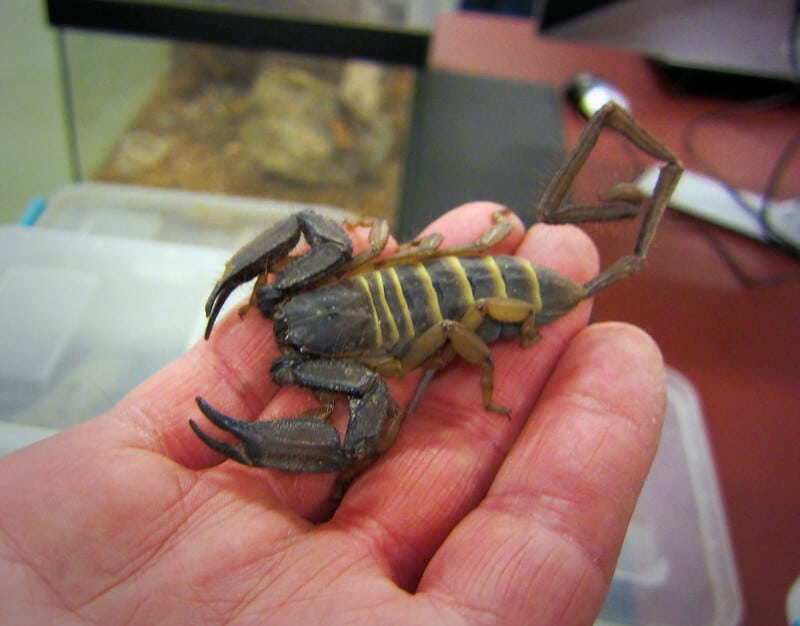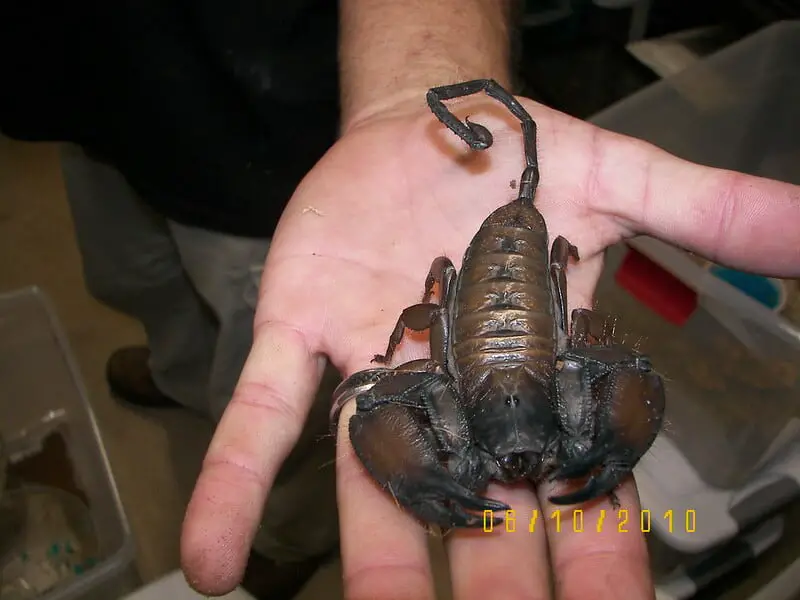The Flat Rock Scorpion (Hadogenes troglodytes) is a terrestrial scorpion species native to South Africa. They’re the longest and most likely the heaviest species in the world, which has made them very desired as pets.
Popular for their size, sturdiness, and long lifespan, it’s easy to care for them as they’re used to challenging environments, which makes living in captivity a breeze for them.
If you’re thinking about getting one of these for your collection, we’ve gathered all the information you need to know to decide whether this scorpion is a good fit for you.
| Name of Species | Hadogenes troglodytes |
| Family | Scorpionidae |
| Common names | Flat Rock Scorpion |
| Type | Terrestrial |
| Native location | South Africa |
| Weight | 1 to 1.5 oz |
| Size | 8 inches |
| Growth Rate | Medium |
| Lifespan | 30+ years |
| Experience required | Beginner |
| Venom | Mild |
| Minimum tank size | 5 to 10 gallons |
Flat Rock Scorpion Overview

The Hadogenes troglodytes are known worldwide as the Flat Rock Scorpion. Native to the deserts and savannas of South Africa, this fantastic scorpion is a lithophilic or rock-dwelling species.
Therefore, it spends most of its time around and between rocks, for which its flat body is fit. Their diet in the wild is primarily mollusks, but they’ll be happy to eat mealworms and crickets in captivity.
Appearance
The Flat Rock Scorpion is famous for having the appearance of a mean and strong scorpion. It’s large, sturdy, flat, and dark, with enormous pincers at both sides of its head.
It comes in either brown or red colors, but its most common appearance is black. It’s easy to tell the FRS apart from other scorpions thanks to the yellow lines that live between the body’s segments, which gives it the appearance of having stripes. The body is also covered with stiff bristles that are usually in lighter tones.
This species exhibits sexual dimorphism, but the differences between males and females aren’t so easy to detect by an inexperienced hobbyist. Males have a longer tail than females and are able to grow slightly longer, but other than that, they’re almost exactly the same.
Price
Flat Rock Scorpions aren’t very expensive pets even though they’re exotic. It’s not difficult to breed them in captivity, so they’re usually available from reputable vendors.
Younger specimens range from $30 to $50 each, while adults can be found for about $80.
Behavior and Temperament
Despite its mean appearance, the Flat Rock Scorpion is a skittish and shy creature that will rather run and hide instead of fencing away threats.
It reacts to small stimuli such as slight vibration by hiding. Even when handling them, it’s very rare for them to sting; also, when it does, the venom is mild so there’s no real danger.
What may cause you discomfort are the pincers, which are large and strong. However, it’s even hard to get harmed by these since they tend to be peaceful.
Handlers should be careful though, since they’ll try to crawl away from your hand, possibly harming themselves if they fall.
Caring for a Flat Rock Scorpion

Temperature and Humidity
The Flat Rock Scorpion lives in the arid climate of the South African desert. They’re used to high temperatures and low humidity, where they’ll find a cooler place between rocks to survive.
Humidity in the enclosure should be around 50%-60%, with temperatures going from 65°F to 75°F.
Substrate
The kind of soil that Flat Rocks Scorpions are used to is coarse, dry, and yet able to retain some moisture.
It doesn’t have to be too deep, but it’ll help provide stability to the rocks placed inside the tank, so around three inches of substrate will work best.
As for the composition, a mixture of three parts sand and one part sterile soil will work well.
Tank
As it has been explored previously, Flat Rock Scorpions enjoy spending time between rocks; you should recreate this environment in their enclosure to help them feel comfortable.
However, you should be careful when you place the rocks in a stable position inside their tanks to keep them from collapsing.
These should be long and flat rocks that you could pile on top of each other and support against the tank’s walls, this way they won’t topple over and fall over your scorpion, injuring it.
They’re great climbers, so your tank should also have a safety lid to keep them from escaping. As for size, you should provide these large scorpions a tank of five to ten gallons to give space for them and their rocks.
Watering
Flat Rock Scorpions are used to living with a low supply of water, getting a large part of their fluid intake from their food. You should still keep a water dish in their enclosure in case they need to drink, but it’s rare to see them take a sip of water.
They’ll get most of their hydration from their food and the slight moisture they may find from light rains.
Spray a scarce amount of water over the substrate once a week, and they’ll have everything they need to be comfortable.
Social
The Flat Rock Scorpion is not a communal species and they will not tolerate tank mates. Housing more than one of these scorpions in a single enclosure will lead to territorial behavior and should be avoided.
They’re not social animals and they do not get lonely, so housing them solitarily is best for them.
Diet of a Flat Rock Scorpion
The Flat Rock Scorpion makes an interesting display when they’re feeding since they take down their prey with their strong pincers.
They’re not hard to feed, so your biggest worry should be removing any uneaten remains when they’re done eating to avoid the growth of fungus.
As for portions, two or three crickets per week will be enough for them if you adapt them to their size.
Baby scorpions should get small crickets, while adult scorpions will be good with two or three large crickets every week.
Lifespan & Health
The Flat Rock Scorpion has a remarkably long lifespan. They can live for up to 30 years with good care!
To keep them healthy, make sure that their enclosure has enough ventilation to avoid the growth of bacteria and mold. For a similar reason, make sure that you remove uneaten food in a timely matter.
Another treat to them is parasites. Wild-caught insects often contain these parasites, so it’s best to feed them captive-bred insects instead.
Lastly, falls are dangerous for this scorpion, so make sure that if you do decide to handle them that you’re very careful.
Fast Facts about the Flat Rock Scorpion
- Since a scorpion’s exoskeleton is very thick and sturdy, molting is a dangerous time for them in which they’re at risk of losing limbs or even dying. Sadly, this is more likely to happen in captivity due to bad environmental circumstances. The risk of your scorpion going through a bad molt is less as long as the temperature and humidity are optimal.
- The Hadogenes troglodytes is considered an endangered species, so you should only buy captivity-bred specimens from reputable vendors.
- Scorpions usually have either a strong pincers strategy or a strong venom strategy. Therefore, just by looking at a Flat Rock Scorpion’s impressive pincers, you’ll know they don’t pack a dangerous venom in their tails.
Final words: Is the Flat Rock Scorpion Right For You?
The Flat Rock Scorpion is a solid acquisition that should be in the collection of every hobbyist. However, make sure not to get it from a poacher since it’s an endangered species.
They’re quite a docile scorpion that does not often exhibit defensive behavior. They might look scary, but they’re actually very gentle. Their venom is also very mild, which makes them a great introductory species for people that are new to keeping arachnids.
- How Long Do American Eskimo Dogs Live? Important Factors and Care Tips - September 29, 2023
- Do American Bulldogs Need Grooming? Essential Tips and Care Guidelines - September 29, 2023
- Do Bengal Cats Enjoy Playing? Essential Tips for Keeping Them Active - September 29, 2023
